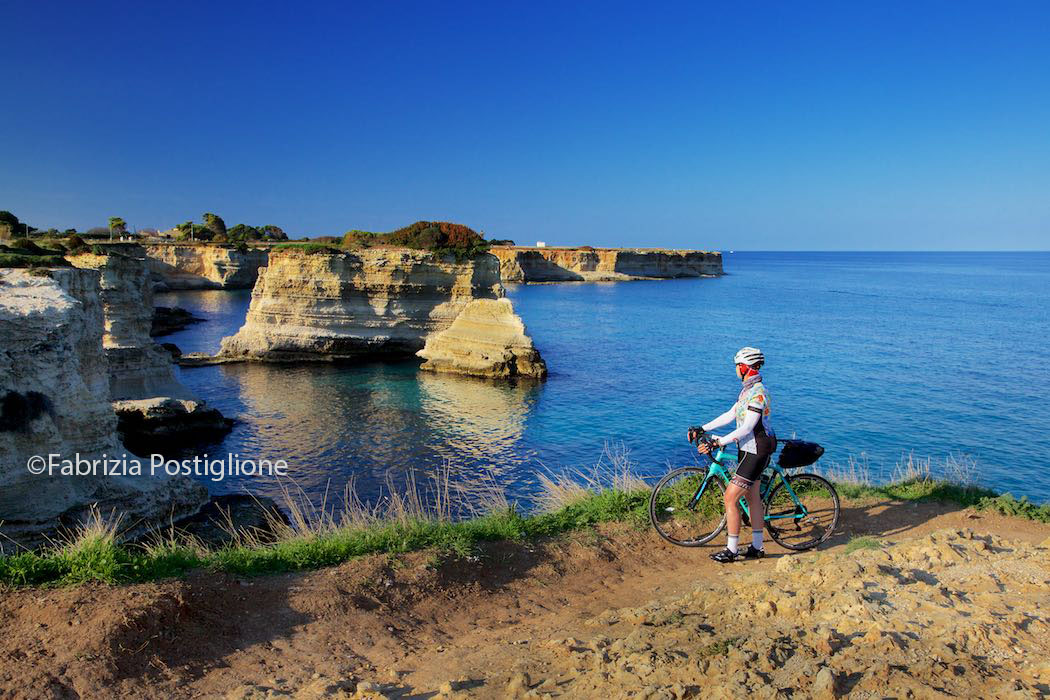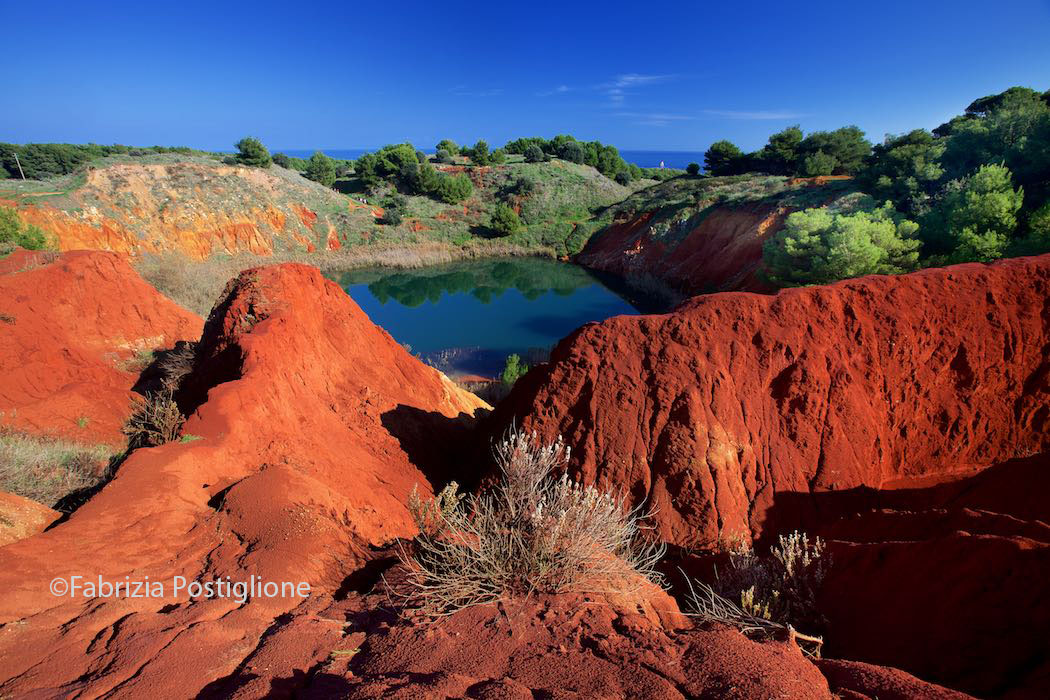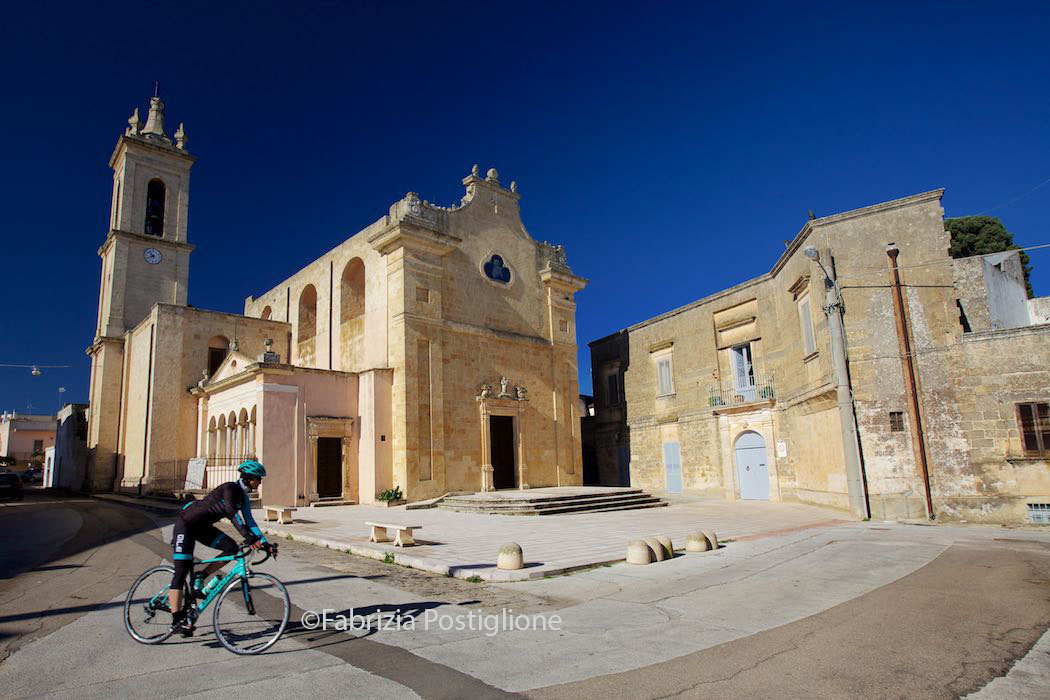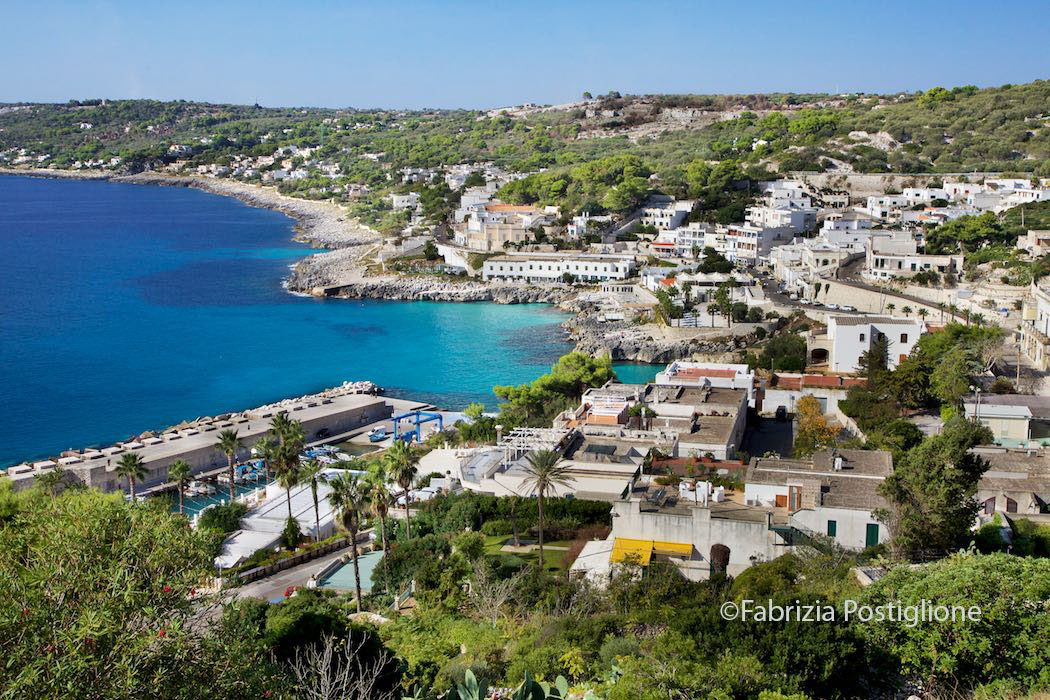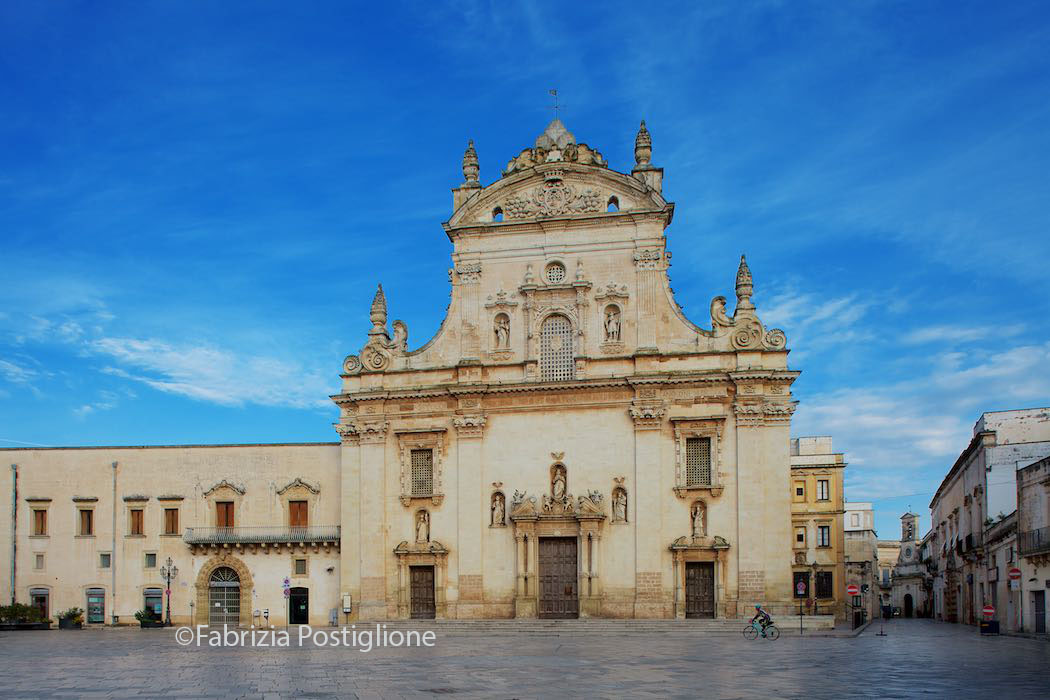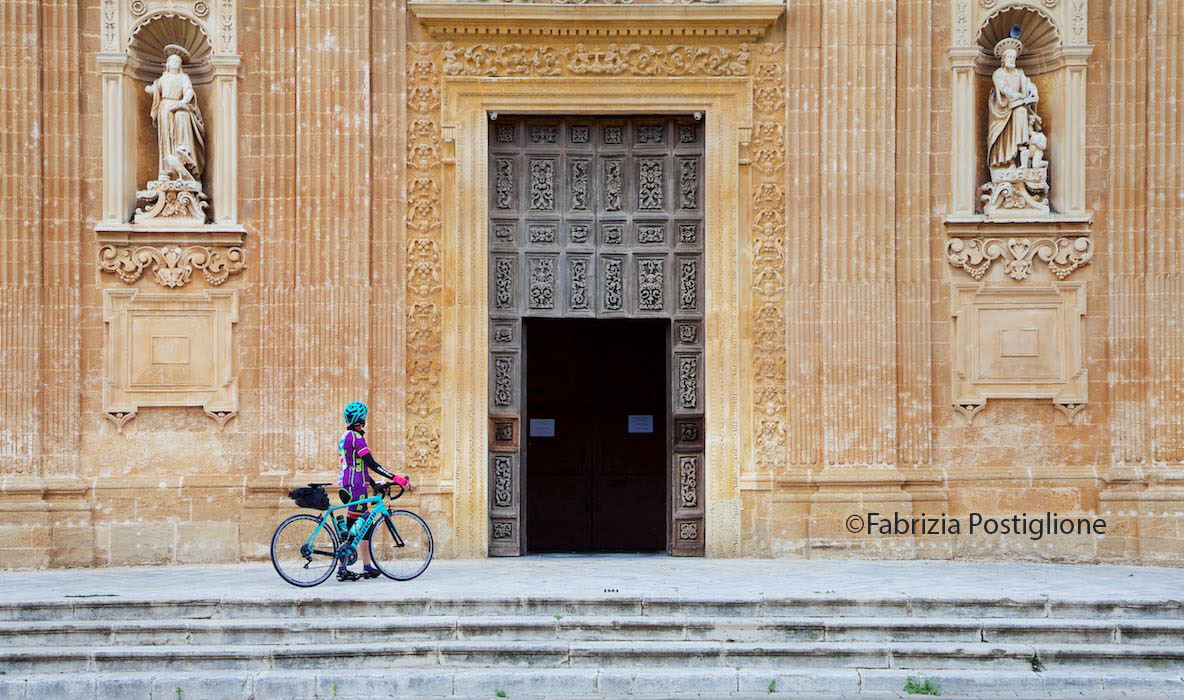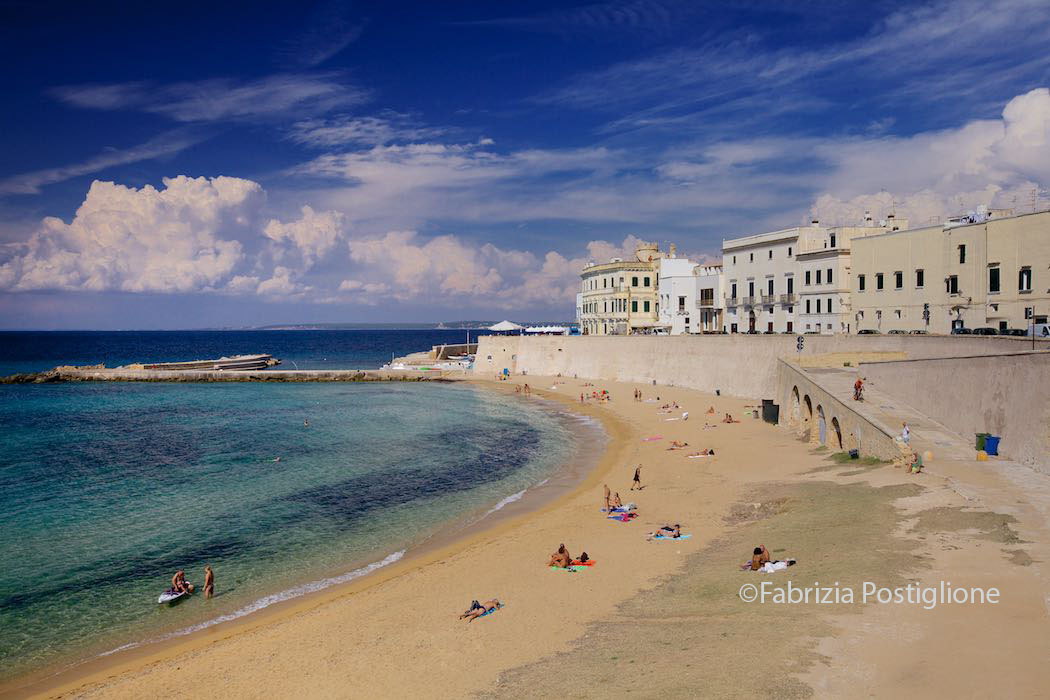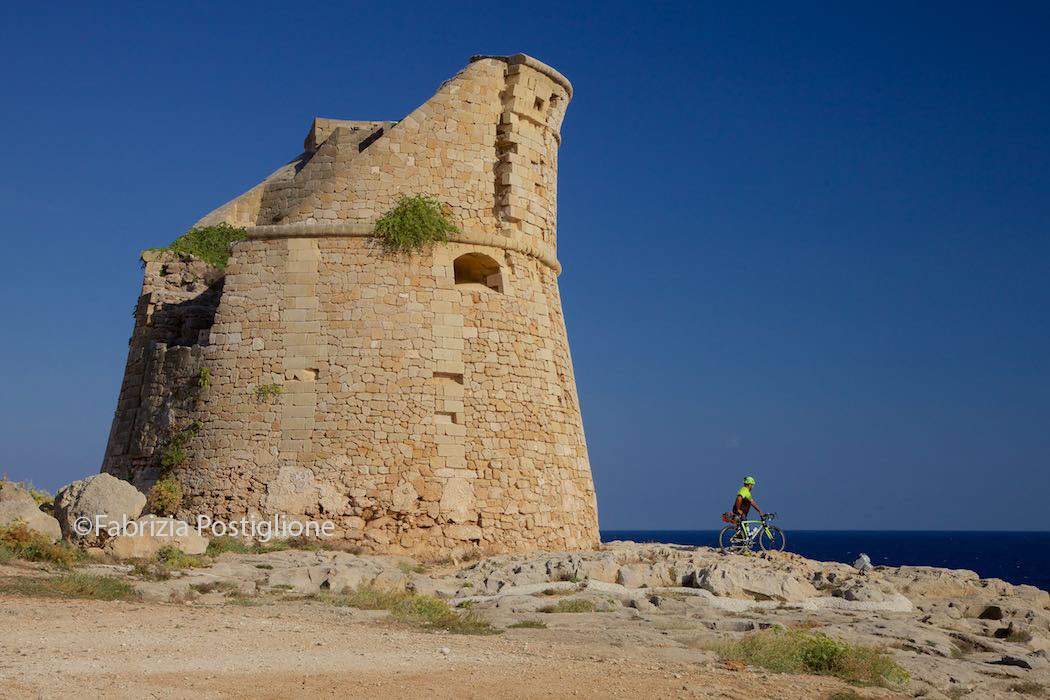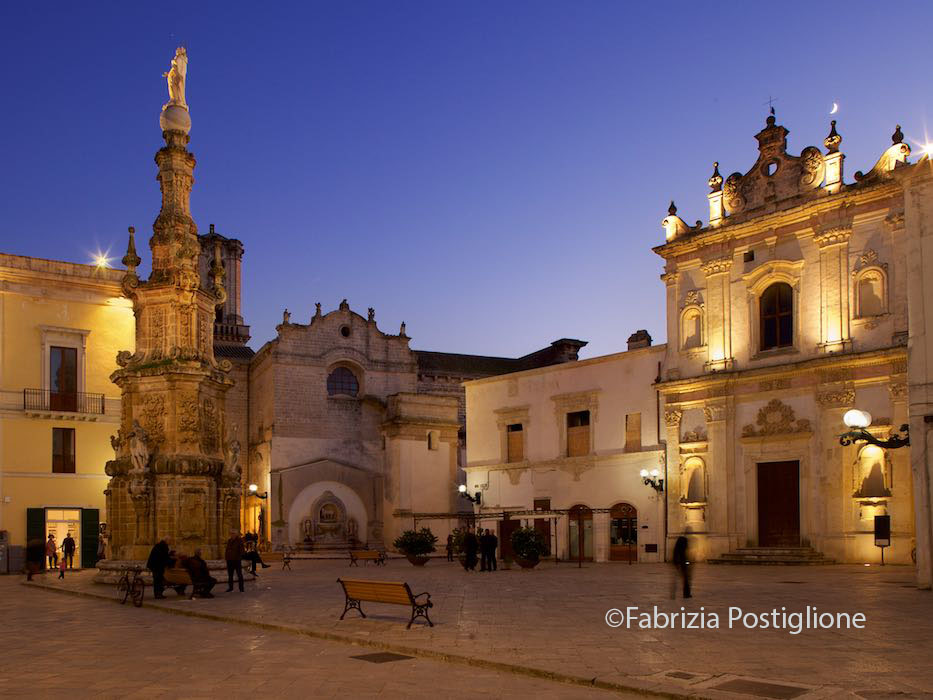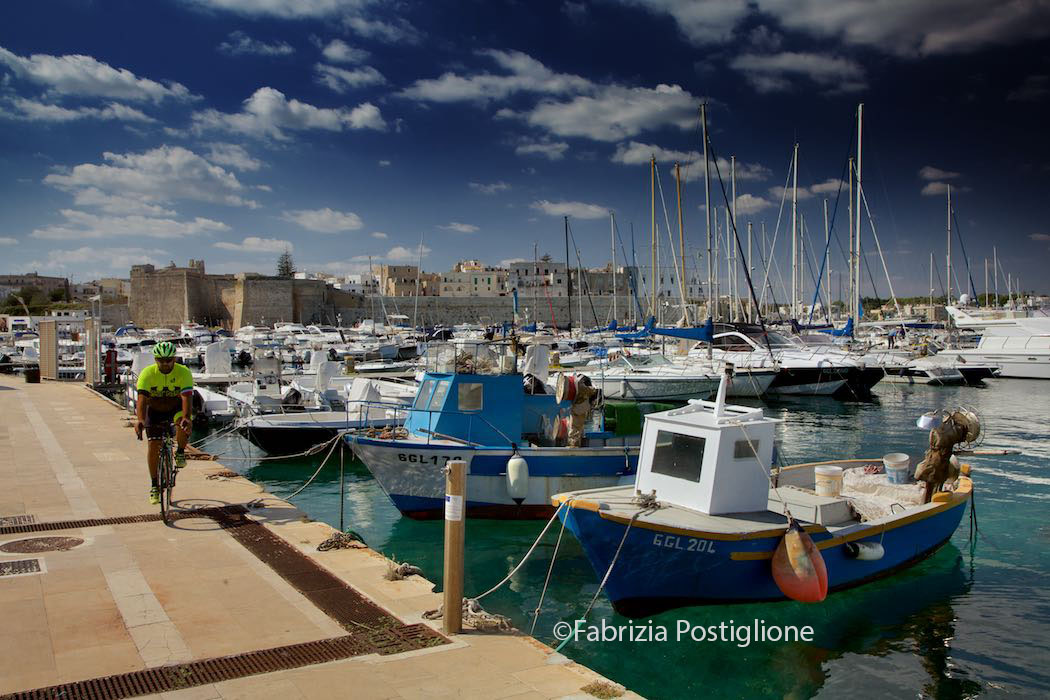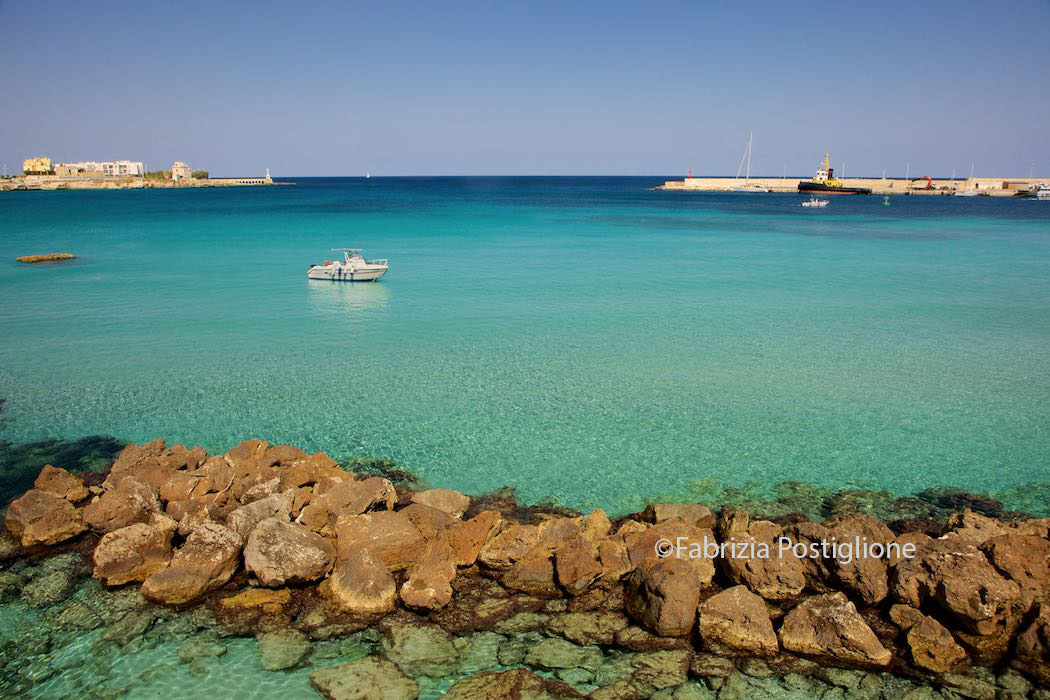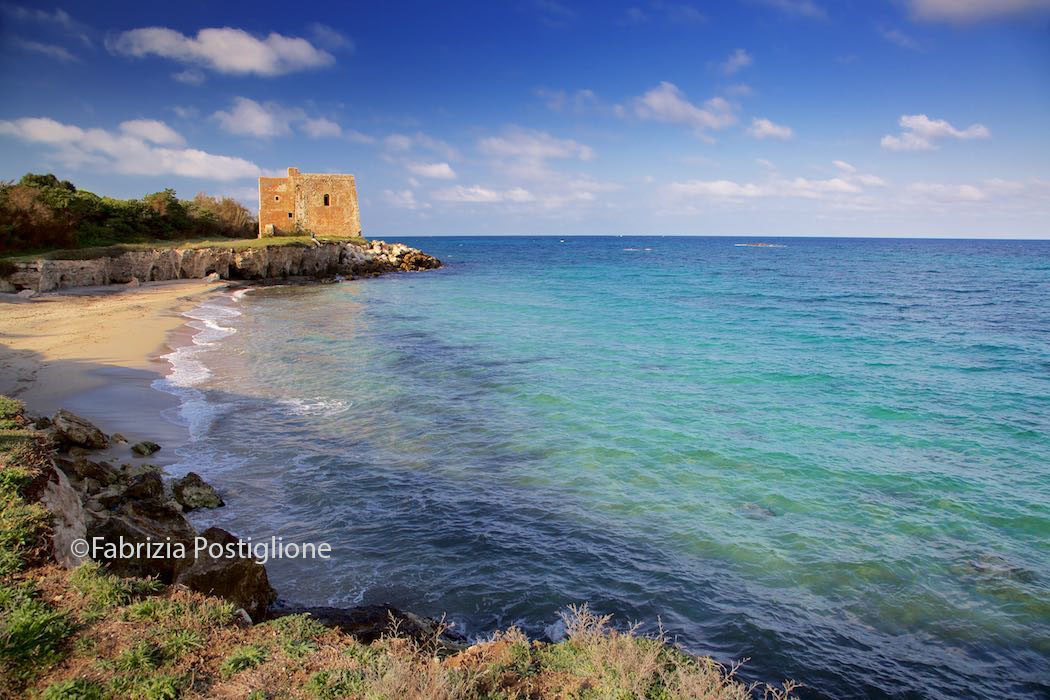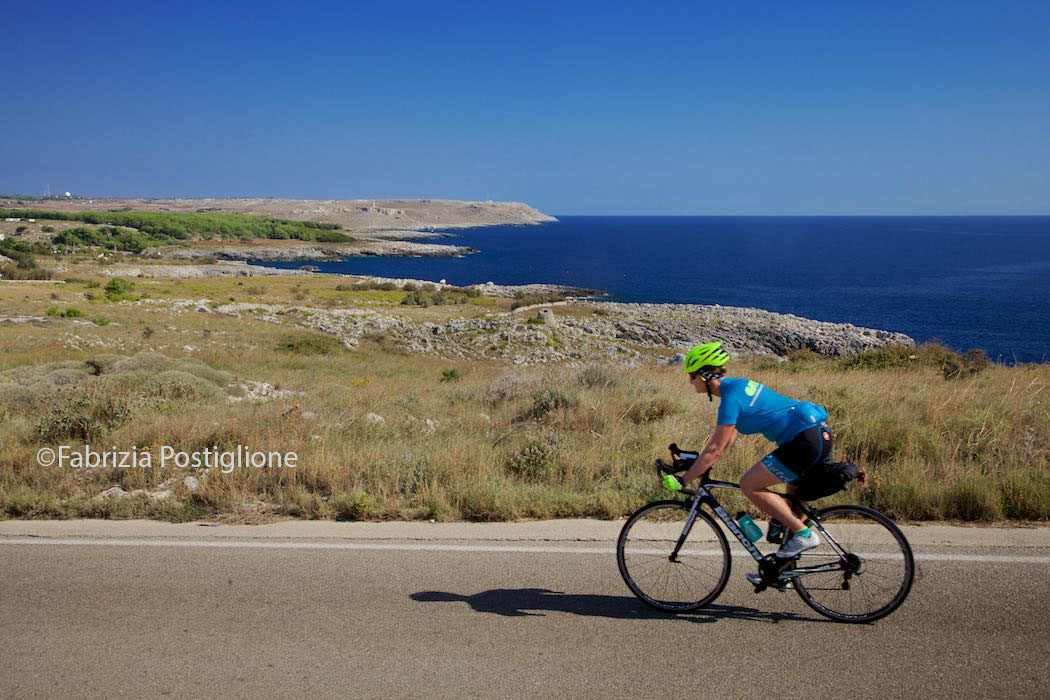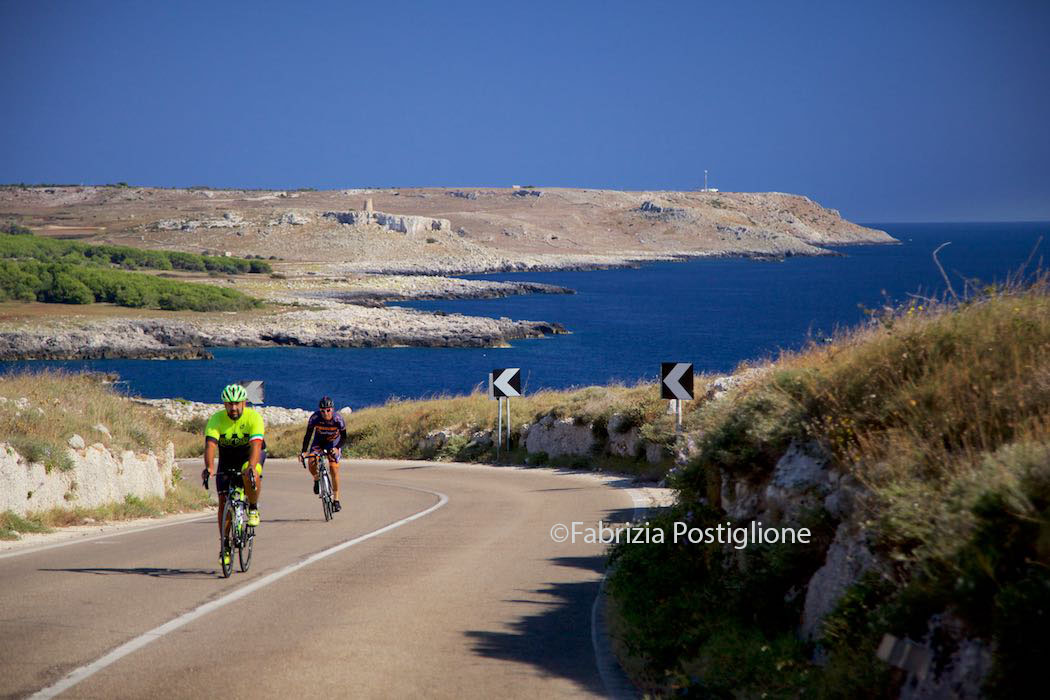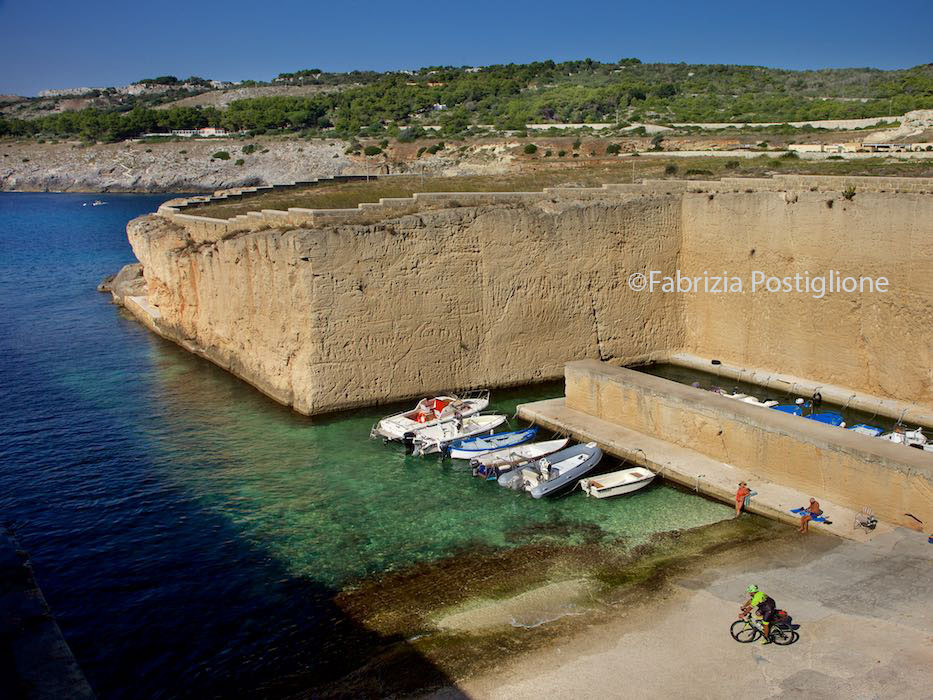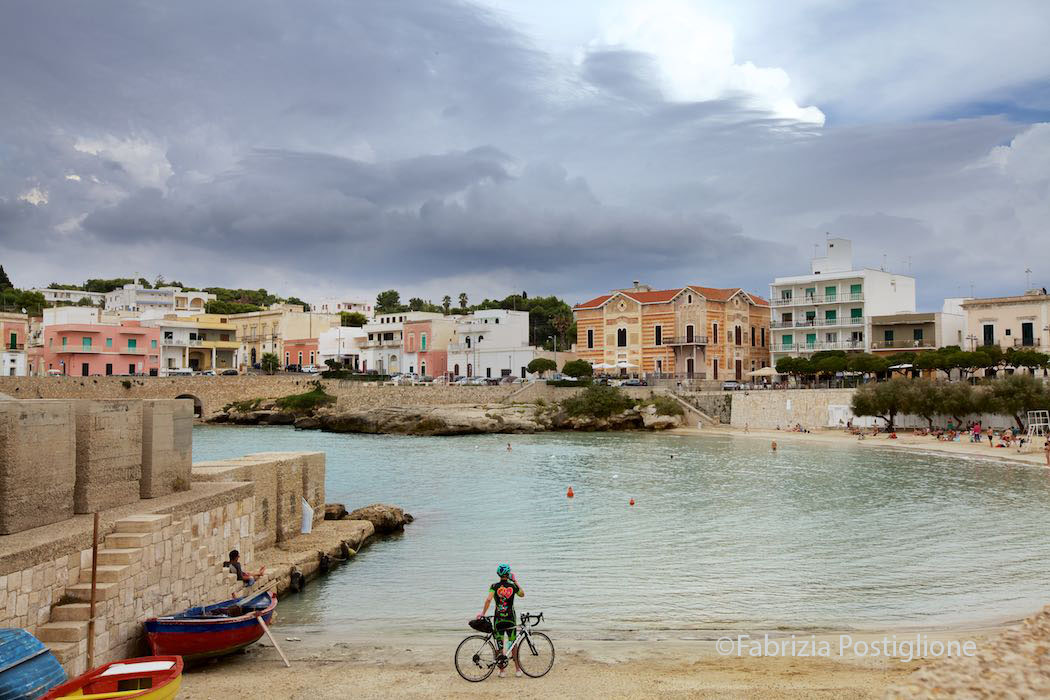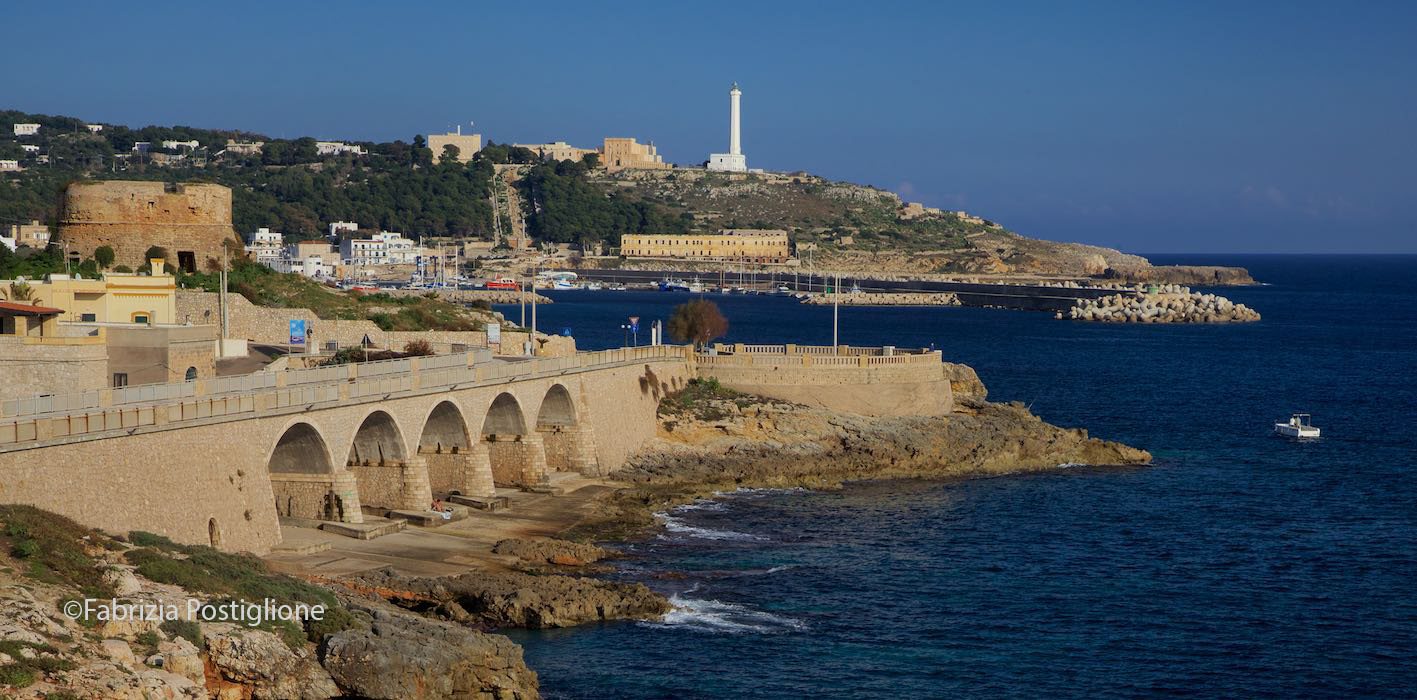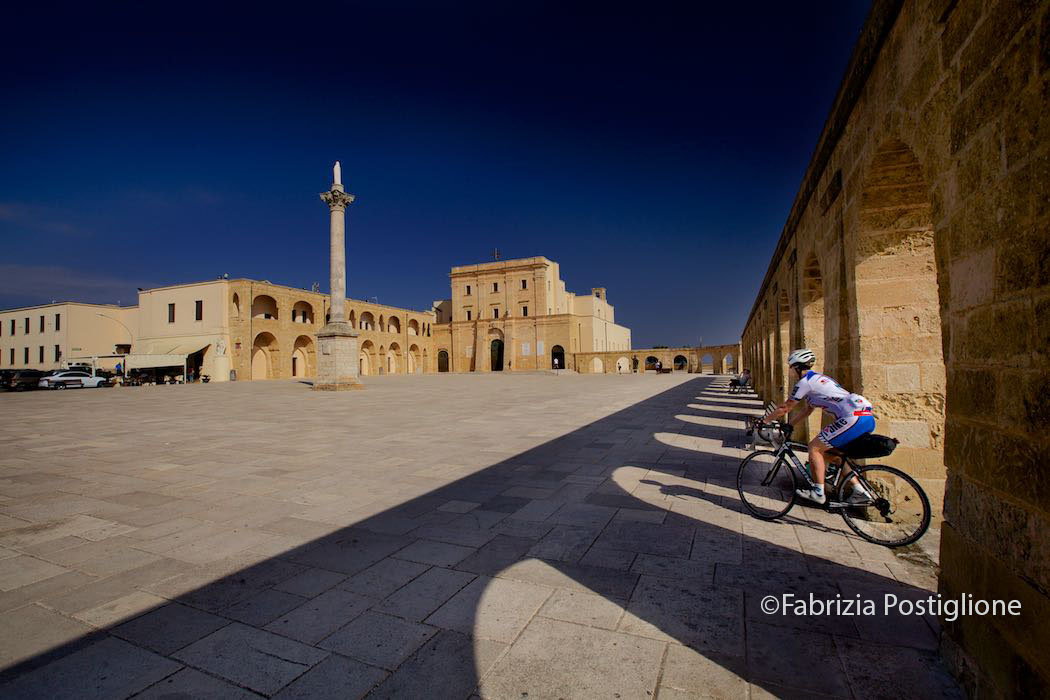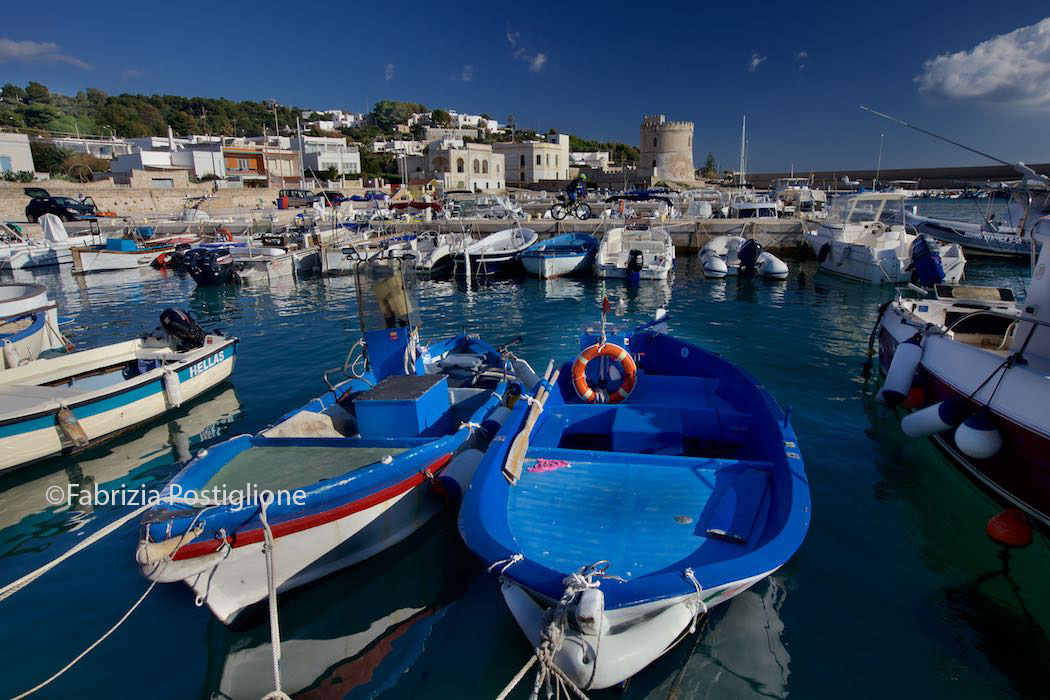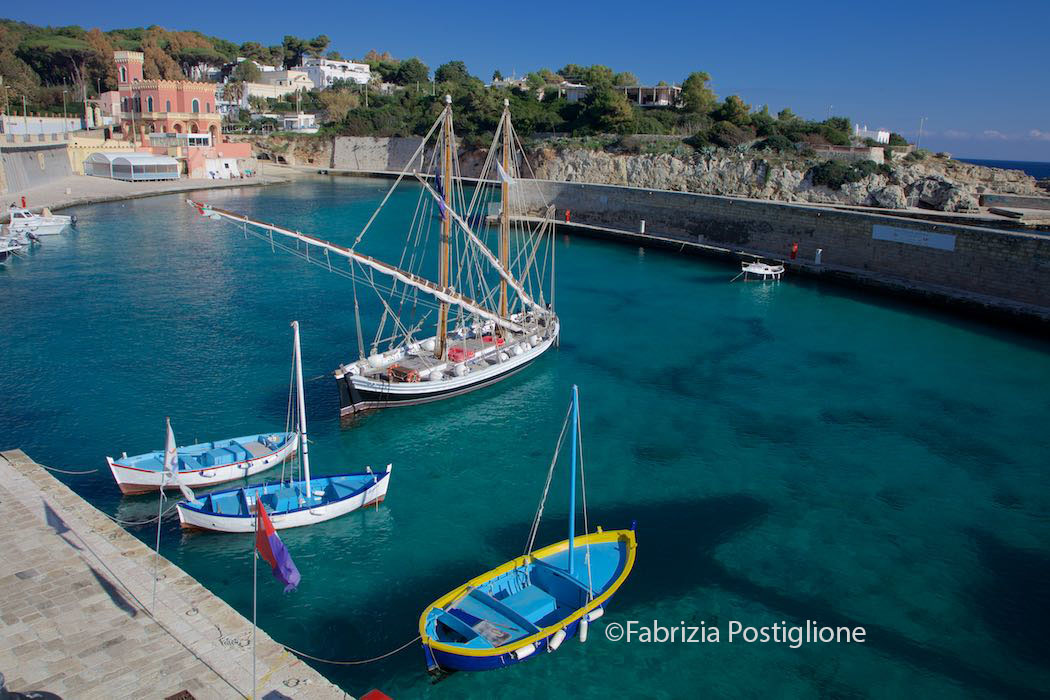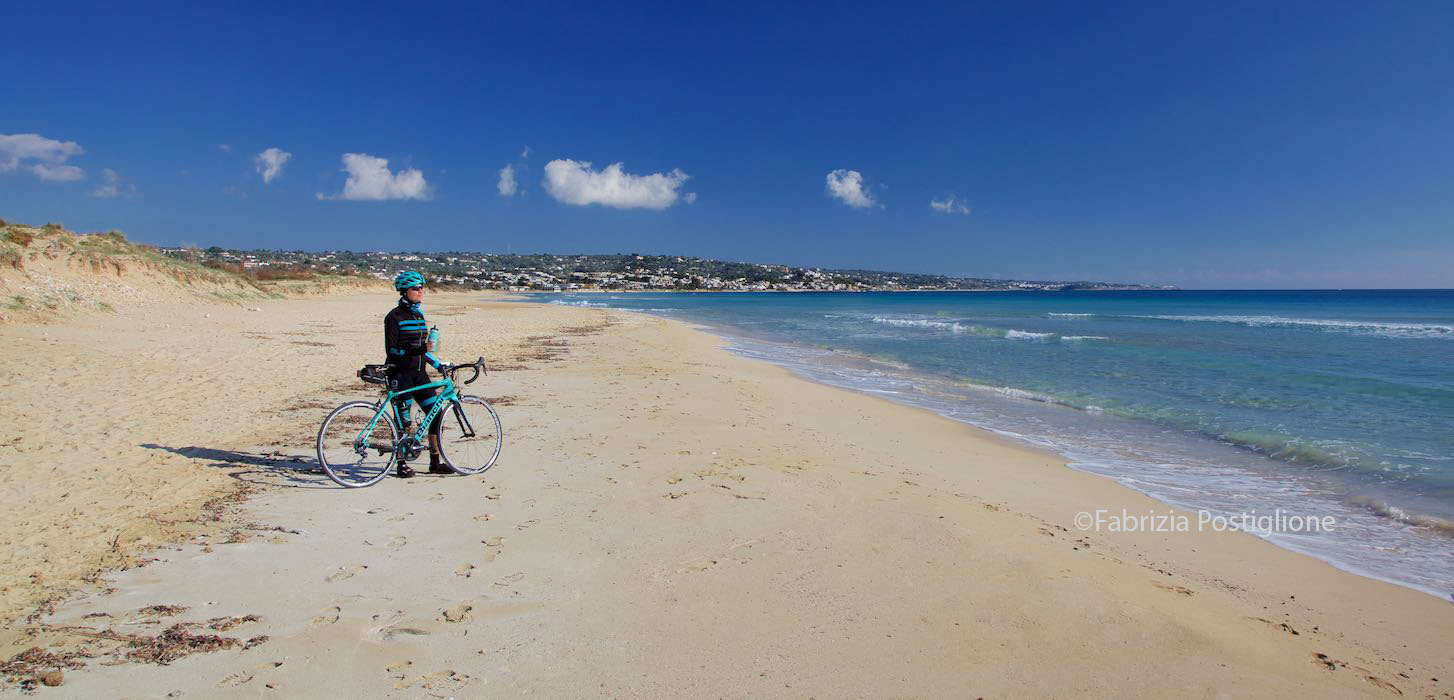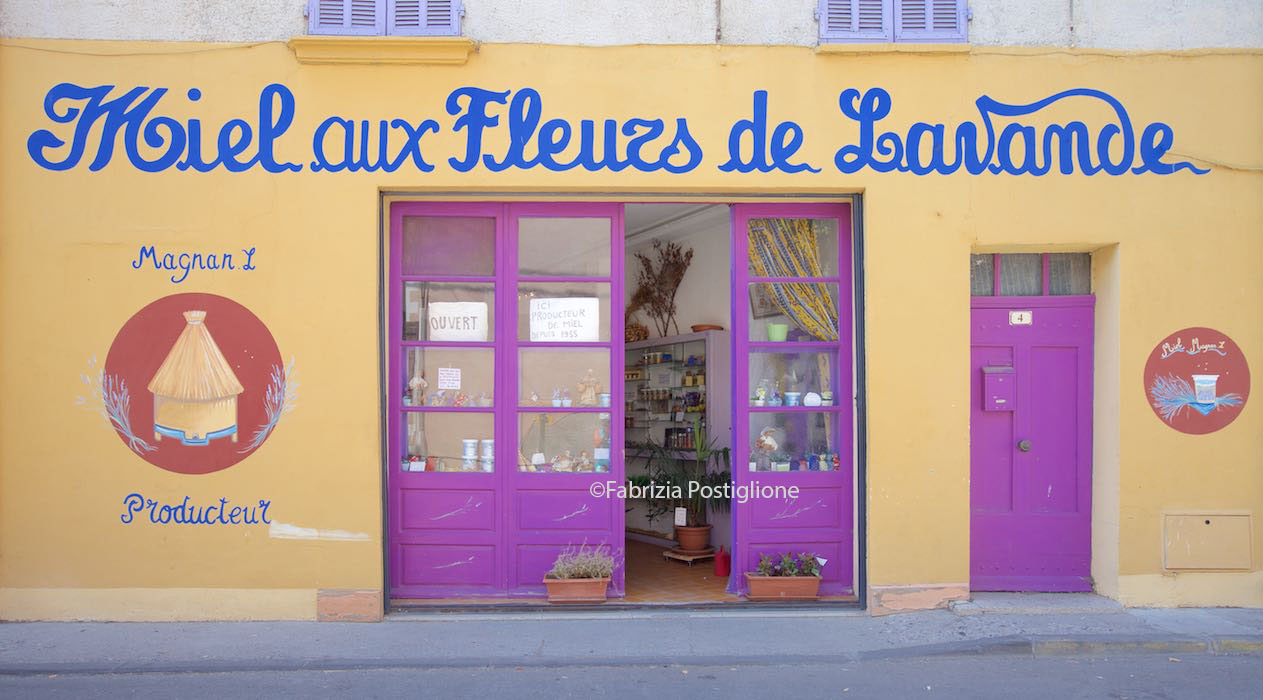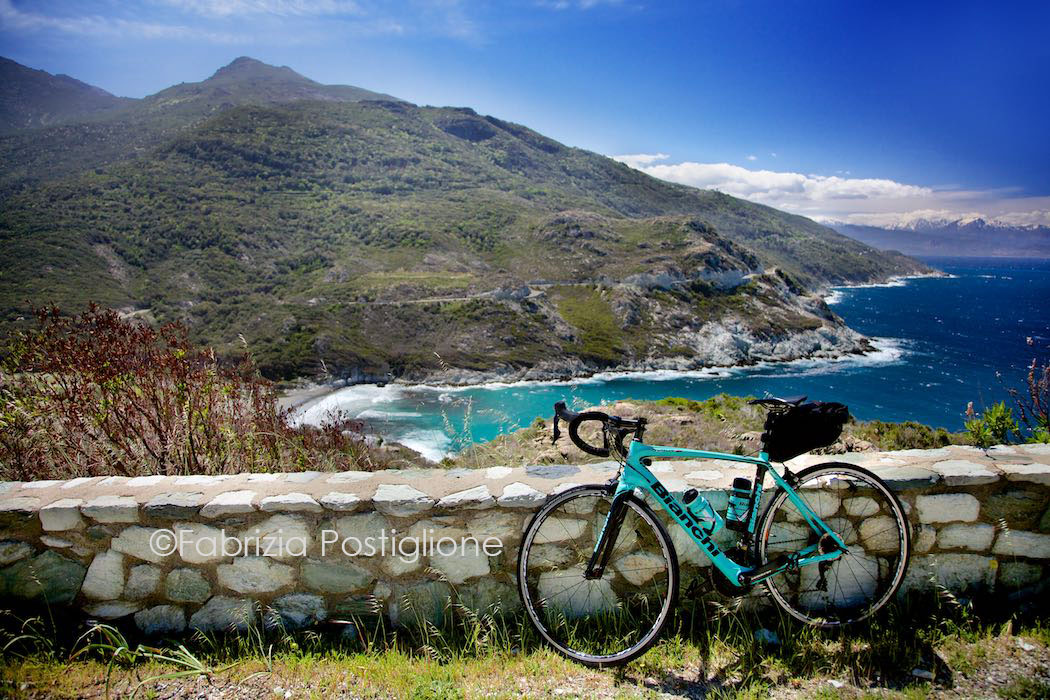IN BRIEF
Stages: 4
Distance: 233,5 km
Total elevation gain: 1615 m
Total riding time (net of stops): about 13-14 hours
Difficulty level: generally easy, excluding the second stage (which is medium level due to the many ups and downs).
Below, at the end of the main article, you can see more details about the itinerary, (with the GPS files stage by stage), the guided tour, the right bike and clothing, plus tips about where to eat, sleep, tourist offices, monuments to visit, etc.
DAY 1
Kalè Polis, or the “Beatiful City”, as the ancient Greeks named Gallipoli, stands on an island in the Ionian Sea, connected to the mainland by a seventeenth-century bridge. From here we leave for the “Giro del Tacco d’Italia” a “Cycling Tour of Italy’s Heel”, that covers about 220 kilometers in the Salento region, and will allow us to dive into a “Maldivian” sea, brown in the sun on white beaches, visit Baroque cities, spot anti-Saracen towers. We will touch towns and villages such as Torre Mozza, Santa Maria di Leuca, Tricase Porto, Castro Marina, Porto Badisco, Otranto, Torre dell’Orso, San Cataldo, Lecce, Copertino, Galatina, Nardò. Salento, the Southernmost area of Apulia (Italy’s “heel”) is one of the hottest destinations of the moment. After the fashion of renovating the trulli (traditional round shaped houses with conic roofs) to convert them into homes for vacationing, the attention of the European cool crowd has moved south and has targeted this block of limestone between the Adriatic and the Ionian Sea. People are attracted by ancient palaces, still available for purchase at competitive prices to then be transformed into houses and hotels. Visitors are fascinated by the thick olive groves, the spectacular beaches and the cities full of amphitheatres, castles, churches, legacy of the colonizations of Greeks, Byzantines, Romans, Normans and Spaniards.
Unlike the new city, which has grown larger on the mainland, often with horrendous agglomerations of concrete, the old city of Gallipoli is a jewel with limited traffic that still lives with the rhythms of the past. The fishermen sew the nets on the pier, go fishing with goiters, and bring fresh fish to the shore, which we then find in the restaurant menus. The Sant’Agata Cathedral is located in the center and at the highest point of the island, a site probably destined to a sacred area since ancient times. For the work the local builders Francesco Bischettimi and Scipione Lachibari were called, who followed the design of the entire factory made by Giovan Bernandino Genuino. Due to the high number of canvases, it can be considered a real art gallery. It is a baroque church of the seventeenth century, rebuilt to replace the ancient Romanesque church dedicated to San Giovanni Crisostomo. Very interesting are also the Angioino Castle of Gallipoli, which dates back to the thirteenth century, and the beautiful buildings of the old city, tangible signs of the splendor of historic noble families.
After riding along the Riviera Sauro and the Riviera Armando Diaz, which follow the circumference of the walls, and having taken a dip from the Puritate beach, we are ready to cross the bridge and flow onto the Lungomare Galilei, flanked by beaches and kiosks of pucce, typical Salento street food, consisting of round loaves, stuffed with aubergines, tomatoes, peppers, zucchini, arugula, chicory, cheese. We then continue south on a flat path that develops along the Ionian coast, passing Torre Suda, Torre San Giovanni, the little harbor of Torre Mozza, the fabulous beaches of Ugento and Pescoluse (the “Maldives of Salento”) up to Santa Maria di Leuca.
This is the arrival point of the first stage: a finis terrae city, flagellated by the wind, where the Ionian Sea and the Adriatic Sea get married, often generating “Californian” waves on which local surfers perform. Embellished with noble villas, Santa Maria di Leuca has a rocky coast dotted with Belle Epoque baths: masonry “dressing rooms” that hid a tub in the rock connected to the sea to bathe away from prying eyes.
DAY 2
Before leaving the town, on the morning of the second day we visit the Basilica-
Sanctuary of Santa Maria de Finibus Terrae.
The first church was built at the dawn of Christianity, on the ruins of a pagan temple dedicated to Minerva, and was subject to constant destruction and looting by the Saracens. The current building dates back to the eighteenth century, with a Latin cross interior with opulent Baroque decorations.
Going up the Adriatic along the spectacular coast overlooking the rugged rocky shore, pockmarked by caves and guarded by towers, we pedal inhaling the scents of the scrub, between terraces and dry-stone walls, without losing sight of the crystal clear sea. The road is a “terrace” on the Otranto Channel and on clear days you can spot the Albanian mountains and the Greek islands. Do not miss a dip in Tricase Porto, a marina lined with restaurants and blessed with emerald water. Further north is Castro Marina, dominated by the village of Castro Superiore, whose origins date back to the Cretans and the Greeks. The sixteenth-century castle towers over a rocky coast without beaches, but you can swim from the pier or from an access point near the Zinzulusa Cave, which is a must visit. A few kilometers and here is Santa Cesarea Terme, a “vertical” city full of stairways, known for its salsoiodic and sulphurous thermal waters. The main road crosses the town characterized by oriental and liberty architecture, among which the nineteenth-century Villa Sticchi stands out. In the highest part of the town is the fourteenth-century Mother Church of the Sacred Heart. On the lower level there are the thermal baths and various accesses to the sea, including the small harbor dug into the tufaceous cliff, where we allow ourselves a refreshing dip. The spectacular asphalt arabesques of the SP 358 continue to unwind along the coast. After the “fjord” of Porto Badisco, the road continues giving exciting views. Shortly after Punta Palascìa, however, it folds inwards. Before Otranto, we turn towards the Instagram perfect ochre, red and yellow scenarios that surround the lake of the former bauxite quarry, a kind of “Apulian Colorado“.
DAY 3
On the third day we visit the easternmost point of Italy’s “boot”: Otranto, the city of the martyrs, a bridge between the West and the East. Its geographical position has always represented a double-edged sword, an opportunity but also a threat to the city, the scene of bloody invasions for the occupation of these lands, once the commercial hub of Salento. Access to the ancient village of the fortified city is the Porta Alfonsina. Among the narrow streets we discover wonders: the Byzantine church of San Pietro, the walk on the ramparts overlooking the sea, the Cathedral (11th century), which preserves the remains of the massacre of the nineteenth century faithful during the invasion of the Turks in 1480, and its floor mosaic, which represents the Tree of Life. The pentagonal Castello Aragonese castle, built in the fifteenth century, is very imposing, with three angular cylindrical towers, now used as a theater.
Further north, after the pine forests of the Alimini Lakes, here are the marinas of Melendugno: Sant’Andrea, with the limestone rocks that emerge from the jade water and the lush pine forest, ideal for resting or having a picnic; then Torre dell’Orso, with the cave of San Cristoforo and the Due Sorelle Rocks, and then San Foca. The arrival point will be Lecce, which we will reach by pedaling first along the coast that points towards San Cataldo, then turning west. The opulent historic center of the so-called “Southern Florence” is ideal for cycling, because it is almost totally closed to motorized traffic.
It is not difficult to succumb to the charm of this 17th century “jewel city”, embellished with palaces and churches built with a golden-creamy stone in the typical local style, the “Lecce Baroque”, a triumph of asparagus columns, gargoyles, and cavorting gremlins. Riding in the Cathedral Square we feel like being in an immense “courtyard” surrounded by the church, the tower, the Episcopio, the Palazzo del Seminario. Above we see a sky so turquoise, it seems photoshopped! Besides the famous monuments, the web of little streets takes us to secret gardens and hallways, among coffee shops where to grab a quick bike and restaurants where young chefs are creating new interesting gastronomic trends.
DAY 4
The last day is dedicated to the visit of some Baroque gems that arise South-west of Lecce.
Copertino, a large agricultural, commercial, artisan and industrial center, was born around the year 1000 a. D. by refugees from some farmhouses destroyed by the Saracens in 942. While pedaling, we admire the trapezoidal-shaped castle of the XVI century, surrounded by a large moat.
Nicknamed the navel of Salento, because it is located in the center of the peninsula, not far from the two seas and Lecce, Galatina is the trendiest city of the moment. Its baroque historic center has become the buen retiroof international trendsetters: artists, designers and gallery owners, fascinated by its authentic beauty, ignored by mass tourist routes. The Church of San Pietro e Paolo di Galatina overlooks San Pietro square, anteroom to the maze of narrow streets where you can get lost while riding. Galatina is an open-air museum of the so called “Lecce Baroque”: from Porta Nuova in Via Siciliani where Palazzo Bardoscia Lubelli is located, the most opulent in the city (1772), up to via Scalfo, with jewels such as Palazzo Pindaro and Palazzo dell’Elefante della Torre, now a private residence furnished with works of design and contemporary art. Do not miss the Basilica of Santa Caterina d’Alessandria, one of the most significant Romanesque monuments in Apulia. The origins of Nardò date back to the 8th-3rd century BC. when it was a center of the ancient Messapi civilization. The city took the name of Nerito (from the ancient Greek nar, water), then was colonized by Byzantine Romans, Normans and Angevins. Piazza Salandra is a riot of Baroque art, with many churches that testify to the undisputed religious and artistic value of a town that already became the seat of diocese in 1413. The “living room” of Nardò also houses the fifteenth-century Guglia dell’Immacolata Concezione, the City Palace, the Sedile. Passing through Galatone, we reach the hemicycle of pastel buildings that dominate a sandy bay in Santa Maria al Bagno and continue south for the last handful of kilometers that will allow us to reach Gallipoli. Here we decide to reach C’est la Vie, a small cocktail bar in the old town, where we admire an amazing sunset, sipping white wine and plucking olives: a well-deserved ending after a beautiful cycle tour in the heart of the most beautiful Salento.
PRACTICAL PAGES
Choosing the right bike for the tour
The route does not present demanding altimetric difficulties, but for the condition of the road surface in some areas, bikes with a good cushioning system are recommended, such as gravel, trekking bikes, MTBs or endurance racing bikes.
Disc brakes can also be very useful, especially if it rains.
Useful tips
It is wise to put in your luggage windproof vests and jackets, gloves, waterproof capes and possibly a pair of extra shoes, especially if you’re planning to ride in spring or autumn, due to the temperature range between day and night and the climate that can change suddenly and become very windy or rainy. Always wear a helmet and use front and rear lights visible even during the day. Pay particular attention on the roads on the Ionian side, where the road surface leaves a lot to be desired. In the summer, however, hydrate yourself continuously, not only with water, but with mineral salts, because the temperatures can be very high and the great sweating can play tricks.
GUIDED TOURS
I Rent Bike (irentbike.it) is an excellent operator specialized in cycling tours in Southern Italy, the Dolomites and the Italian Alps. My positive experience in previous tours has made me choose it for this trip. The package In the Heart of Salento exactly traces the journey proposed in this article and includes: 6 days / 5 nights in half board in the hotel, cycling guide, technical assistance throughout the tour, luggage transport, van in tow, energy bars and supplements throughout the stay. Prices: in May-June for 7/8 participants the tour costs from 990 € per person, for 12 people it costs 900 € per person in double room. In July and September the trip costs € 1190 or € 1070 respectively. For the month of August the costs rise to € 1390 and € 1250. In these fees, participants are meant to have their own bikes.
If you want to rent a bike for the entire cycle tour, the supplement is: € 150 for racing bikes and e-bikes or € 80 for trekking bikes and MTBs.
Among the services not included in the price: tickets for archaeological sites, packed lunches, and everything not mentioned above.
PLEASE NOTE: Prices may vary according to: the number of participants, the choice and availability of hotel facilities or the chosen season. At the time of booking the tour operator will make a detailed quote.
ABOUT THE ITINERARY
I designed a loop that starts from Gallipoli and proceeds south along the Ionian coast and then north on the Adriatic coast counterclockwise, passing through Torre Mozza, Santa Maria di Leuca, Tricase, Castro, Porto Badisco, Otranto, Torre dell’Orso, San Cataldo, Lecce, Copertino, Nardò, Galatina, Galatone and finally Gallipoli again. The route covers a total of 233,5 km and takes place in four stages, rich in historical and naturalistic attractions.
Stages: 4
Total distance: 233,5 km
Total elevation gain: 1615 m
Total riding time (net of stops): about 13 – 14 hours
Difficulty level: generally easy, excluding the second stage (which is medium level due to the many ups and downs).
THE ITINERARY IN DETAIL
Day 1: Gallipoli – Santa Maria di Leuca
Distance: 52,9 km
Riding time: 2 h 30 min – 3 hours
Altitude gain: 279 m
Altitude loss: 268 m
Difficulty level: easy
GPS file: https://ridewithgps.com/routes/32290847
The route of the first stage is mainly flat and almost always develops close to the coast, except in some one-way sections that force us to use roads further away from the seaside.
To exit Gallipoli we enter the SP 200 which later becomes SP 239 and then changes again and becomes SP 215. Once in Torre Sinfono, continue on the SP88 up to Marina di Ugento. From there you continue on the SP91 to the town of Salve di Lecce and then you can visit Torre Vado a little further on. After passing through the town, you enter the SP214 at the beginning of Marina di Felloniche, which will take you to Santa Maria di Leuca. Remember that at Marina San Gregorio the road climbs a bit and does a few ups and downs until Santa Maria di Leuca.
DAY 2: Santa Maria di Leuca – Otranto
Distance: 52,4 km
Riding time: 3h 30 min – 4 hours
Altitude gain: 728 m
Altitude loss: 731 m
Difficulty level: medium
GPS file: https://ridewithgps.com/routes/32290960
This stage is the most spectacular from a landscape point of view, because the route almost always follows the coast overlooking the sea and goes up the Salento east coast. There are many ups and downs so it is also the toughest day of the whole itinerary. We start from Santa Maria di Leuca and we always stay on the SP214 until the end of the inhabited center; then we continue on a stretch of the SP124 up to the sanctuary of Santa Maria di Leuca. Once you start again, you get onto the SP358, which also offers the best road surface among all the cycling routes you’ll be riding in Salento. This beautiful state road allows us to visit very pretty places, such as Tricase Porto and Castro Marina. Reached Porto Badisco, continue on the SP87 up to Otranto. Just before the center of Otranto, there is the possibility to visit the bauxite quarry. Remember that there is a small dirt track where you need to be very careful. After passing a barrier, dismount and walk the bike, in order to reach the edge of the pond of the former quarry.
DAY 3: Otranto – Lecce
Distance: 56,7 km
Altitude gain: 288 m
Altitude loss: 236 m
Riding time: 2h 30 min/3 hours
Difficulty level: easy
GPS file: https://ridewithgps.com/routes/32291044
From Otranto we head north on the SP366, we skirt the lakes of Alimini Piccolo and Alimini Grande on the east side, until we reach Torre Dell’Orso in via Lenin, which will lead us to the village and allow us to continue on the same SP366 again to reach up to a few kilometers from the center of San Cataldo. From here, continue on the SP364 for a small stretch and then take Via della Libertà which will lead you to the center of Lecce, also following a stretch of cycle path.
DAY 4: Lecce – Nardò – Galatina – Galatone – Gallipoli
Distance: 71,5 km
Altitude gain: 320 m
Altitude loss: 381 m
Riding time: 4h 30 min
Difficulty level: easy
GPS file: https://ridewithgps.com/routes/32291123
This is also a stage with very little altitude gain. Watch out for the often damaged road surface. Leaving the Cathedral Square, in the center of Lecce, we continue along Via Marco Gasseo and then Via Gallipoli towards Via Rudiae and the SP 16 towards Copertino.
From here, we ride south along the SP 14 and SP 15 towards Nardò. In order to reach Galatina, we turn east crossing the “Zona Industriale” on the SP 19, then we take a little stretch the SS 101 and then we head south-east along the SP 18.
To exit Galatina we ride south-west on the SP 47 and reach Galatone.
We continue to Gallipoli taking the SP231, the SP 194 and then we turn left on the SS101 and on the SP 52 that ends up in a roundabout. Here we take Via Lecce and the Lungomare Marconi to reach the old town of Gallipoli.
WHERE TO STAY
KissfromSalento B & B + Bike
Lecce (LE) Via dei Figuli 13, tel. 003934040580; kissfromsalento.it.
A B&B located in the beating heart of art, shopping and nightlife in the historic center of Lecce, near C.so Vittorio Emanuele, the former Sant’Anna Conservatory, the Duomo and the former Palmieri boarding school. It has a beautiful terrace on the roofs of the old city. The bikes are kept in the private bicycle workshop, well equipped and with free consumables. Possibility of e-bike rental. Delicious breakfast with food for cyclists.
Agriturismo La Palascìa
Otranto (LE) Masseria Agreste S.P. 87, tel. 329 1490929; agriturismolapalascia.it. This eighteenth-century masseria (typical farmhouse) has rooms in rustic Salento style and is located on the coast road 3 km south of Otranto, at the gates of the Otranto-Leuca Natural Park. A very friendly hotel for cyclists, it offers abundant breakfast with organic products of its own production: fruit, jams, sweet and savory cakes, fresh eggs to start the day on the bike with energy. Small bicycle workshop, closed room for bikes, maps with cycling routes.
Hotel Terminal
Santa Maria di Leuca (LE) Lungomare Colombo 59, tel. 0833 758242; carolihotels.com. It stands between the nineteenth-century villas on the waterfront, and overlooks the inlet bordered by Punta Ristola and Punta Meliso. Each room is dedicated to a Salento monument reproduced in a painting and is decorated with handicrafts. Restaurant with menu based on vegetables, flours, preserves, fruit oils and wines grown specifically for the hotel. The hotel boasts a also a swimming pool, private beach, yacht club, congress center.
Masseria L’Antico Frantoio
Gallipoli (LE) S.P. 52 Gallipoli-Sannicola, locality Crocefisso, tel. 327 75 30 505; masserialanticofrantoio.it. A few steps from the beaches of Gallipoli, this beautiful farmhouse was created from a seventeenth-century olive press, immersed in thyme, rosemary and lavender bushes. There are seven rooms and one suite furnished in simple Salento style, a restaurant and a spa.
Hotel Resort Mulino a Vento
Uggiano la Chiesa (Lecce) Via Palombaro 13, tel. 0836 812942; mulinoavento.it. It is part of an underground 1688 oil mill and is located less than 4km from Porto Badisco, Enea’s first landing in Italy. The rural complex is surrounded by olive trees and Mediterranean scrub, and it’s perfect for “cycle-travelers” who want a family welcome in the Salento countryside. The hotel offers swimming pool, garden, bicycle workshop, bike room, robust breakfast for cyclists, cycling maps, bike rental.
WHERE TO EAT (restaurant prices are intended for an average three course meal, without beverages and may vary according to the season)
Ascalone Pastry Shop
Galatina (LE), Via Vittorio Emanuele 17, tel. 0836 566009.
This is the “cradle of pasticciotto” in Galatina. The owners have handed down the original recipe for the pasticciotto, the typical Salento pastry made with shortcrust pastry filled with custard, for generations. They are prepared by hand (with lard) and should be enjoyed lukewarm.
L’Angolino in Via Matteotti Typical Pucceria
Lecce (LE) Via Giacomo Matteotti 31, tel. 346 836 1999
The “puccia” is the typical Salento street food, based on a loaf of bread, filled with delicious veggies and cheese or meat. In this “pucceria” you can taste a very savory light dough for the “loaf” and excellent well seasoned local ingredients (from tomatoes to eggplants). A good address for a tasty and quick snack. Average bill: € 5
Lido Azzurro Restaurant
Marina di Leuca (LE), Via Cristoforo Colombo, Tel. 388 653 4361
Good seafood cuisine to be enjoyed on a beautiful terrace on the beach.
Taste the raw fish, the fried fish, the cuttlefish pie, the fig cheesecake. Average bill: 35 €.
Peccato di Vino Restaurant
Centro Storico Otranto (LE), Via Rondachi 7/9, Tel. +39 0836 801488.
Intimate place with a nice outdoor area in an alley of Otranto old city, near the Cathedral. Creative dishes based on local tradition, made with excellent local ingredients. Very kind owner and staff. Average bill: 35 €.
Matre
Gallipoli (LE) Via Antonietta De Pace 116; matre.it.
The restaurant is located in the historic center and offers traditional local recipes, especially based on fish, reinterpreted with a special passion for genuine ingredients and experimentation, such as swordfish sashimi and lobster ravioli. In the bistro at the entrance of the restaurant – open for lunch, for an aperitif or after 10.30pm – you can enjoy cold cuts, cheeses, cold seafood dishes, salads and typical products, wines by the bottle or by the glass. Average bill: 40 €.
Trattoria Anima & Cuore
Galatina (LE) Corso Garibaldi 7, tel. 0836 564301, animaecuore.it.
On the first floor of an eighteenth-century building, between mosaic floors and frescoed ceilings, you can enjoy a refined cuisine of sea and land, together with vegan delicacies. The tables overlooking the courtyard are very romantic. Do not miss the cooked and raw seafood appetizers; the maccheroncini with purple shrimp from Gallipoli and pistachio from Bronte; the orecchiette mixed with turnips and seasoned with monkfish ragout, cherry tomatoes and Nardò olives; the fish tartare with tomatoes buckets. Tasting menu: 45 €.
MONUMENTS TO VISIT
Gallipoli Castle
Gallipoli (LE) Rampa Castello, tel. 0833 262775; castellogallipoli.it. Schedule:
January, February, November and December every day except Monday 10-13 and 15-17; March and October 10-13 and 15-18 closed on Mondays; April and May every day; 10-13 and 15-19; June and September every day 10-21; July August every day 10-24. Admission: € 5.
Cathedral of Sant’Agata
Gallipoli (LE) Via Duomo 1 0833261987; cattedralegallipoli.it. Free entry.
Sanctuary of Santa Maria de Finibus Terrae
Santa Maria di Leuca (LE) Piazza Giovanni XXIII 0833758636; basilicaleuca.it. Hours: 7-12: 30 and 15-19. Free entry.
Zinzulusa cave
Castro (LE) Piazzale Zinzulusa 0836 943812; grotta-zinzulusa.business.site. Hours: every day 10-18. Admission: € 3.
Cathedral of Santa Maria Annunziata
Otranto (LE) Piazza Basilica 1 0836 802194; comune.otranto.le.it. Hours: 7-12: 30 and 15-20 in summer; 7-12 and 15-17 in the rest of the year (exceptions are made when religious services are held). Free entry.
Aragonese Castle
Otranto (LE) 0836 210094; castelloaragoneseotranto.com. Hours: every day 10-20. Admission: € 3, plus underground castle € 5.
Copertino Castle
Copertino (LE) Piazza Castello 0832 931612; musei.puglia.beniculturali.it. Hours: Monday-Saturday 8.30-13.30, closed Sunday.
Church of San Pietro e Paolo
Galatina (LE) Piazza San Pietro, 0836566552. Hours: 7-19.30. Free entry.
Basilica of Santa Caterina
Galatina (LE) Via Raimondello Orsini 0836 568494; basilicaorsiniana.it. Hours: Monday-Saturday 8.30-12.30 and 15.30-17.20. On holidays when there is mass, it is open only from 15.30 to 17.20. Free entry.
Palazzo del Sedile
Nardò (LE) Piazza Salandra 0833838308. Free entry.
TOURIST OFFICES
Web Resource: viaggiareinpuglia.it
IAT Lecce
Via Vittorio Emanuele n.24
Tel: 0832.332463-248092
Pro Loco Gallipoli
Via Kennedy, tel. 0833264283 e 3510155306
Pro Loco Otranto
Via Laggetto
Tel.: 0836 806585 e 335 6770149
www.prolocotranto.it
IAT Santa Cesarea Terme
Via Roma, 209
Tel: 0836.944043
IAT Galatina
Sala Orologio – via V. Emanuele II, 35, tel. 0836569984
IAT Nardò
Piazza Salandra, tel. 0833 836928
I.A.T. Copertino
Via M. di Savoia, 71 Tel.: 0832949010
Pro Loco Santa Maria di Leuca
Via Cristoforo Colombo 53, tel. 0833758161


